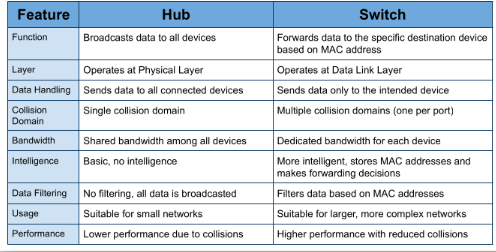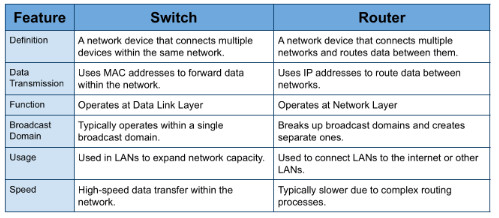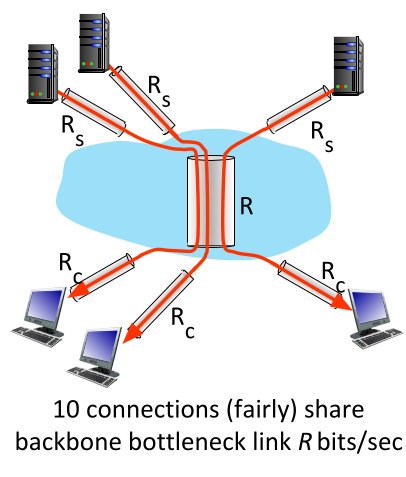The Internet: A Nuts and Bolts View
The idea of networking is to transfer arbitrary data between two or more computers over the internet/LAN.
- Host: Named end-systems running apps at the internet’s edge
- Packet Switching: Forwards packets over routers and switches
- Communication lines: Media. i.e. Radio, LTE, Fiber
- Internet: A network of networks via interconnected ISPs
- Protocols: control the sending and receiving of messages.
- Internet Standards: RFCs, IETF
- Infra: provides services to applications, web streaming, email, gaming
Important
Protocols define the format, order, of messages Tx and Rx among network entities, and actions taken on message transmission, receipt.
OSI model
| # | Layer | Ex |
|---|---|---|
| 7 | Application | HTTP |
| 6 | Presentation | SSL/TLS |
| 5 | Session | Sockets, TCP |
| 4 | Transport | TCP, UDP |
| 3 | Network | IPv{4,6} |
| 2 | Data link | Ethernet |
| 1 | Physical | DSL |
Network Edge
- Hosts: clients, servers
- Servers in data centers
- Access networks, physical media
- wired and wireless network links
- Network Core:
- interconnected routers
- network of networks
DSL
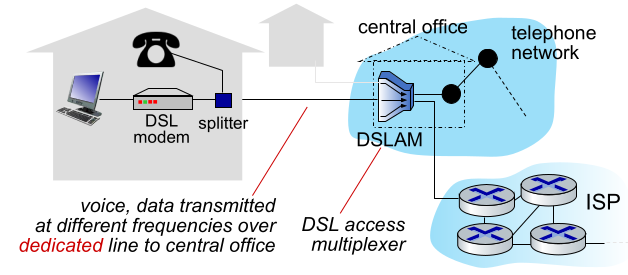
- Uses existing telephone line to central office DSLAM
- data over DSL phone line goes to Internet
- voice over DSL phone line goes to telephone net
Info
- A high-speed downstream channel, in the 50 kHz to 1 MHz band
- A medium-speed upstream channel, in the 4 kHz to 50 kHz band
- An ordinary two-way telephone channel, in the 0 to 4 kHz band
- 24-52 Mbps – DL transmission rate
- 3.5-16 Mbps – UL transmission rate
- Asymmetric access
Wired Cable
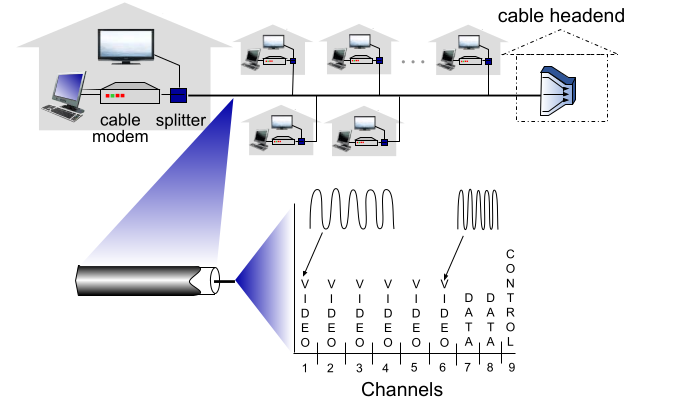
Frequency division multiplexing (FDM): different channels transmitted in different frequency bands.
Info
- HFC: hybrid fiber coax
- Asymmetric: up to 40 Mbps – 1.2 Gbs downstream transmission rate, 30-100 Mbps upstream transmission rate
- Network of cable, fiber attaches homes to ISP router
- homes share access network to cable headend.
Home Networks
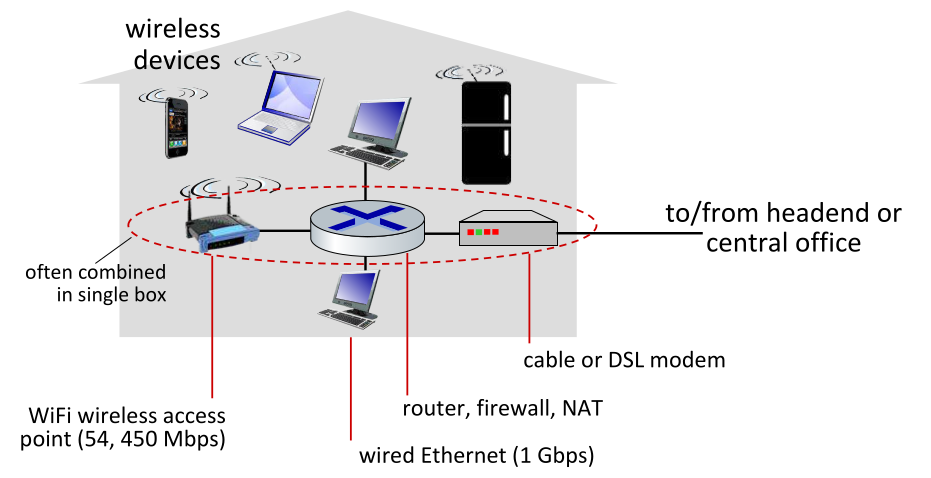
Enterprise Networks
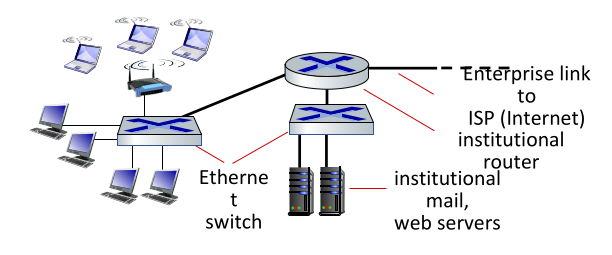
Deployed at companies, universities, etc.
Note
- Mix of wired, wireless link technologies, connecting a mix of switches and routers (we’ll cover differences shortly)
- Ethernet: wired access at 100Mbps, 1Gbps, 10Gbps
- WiFi: wireless access points at 11, 54, 450 Mbps
Wireless Networks
Shared wireless access network connects end system to router via base station aka “access point”.
- Wireless local area networks (WLANs)
- Typically within or around building (~100ft)
- 802.11b/g/n (WiFi): 11, 54, 450 Mbps transmission rate to Internet
- Wide-area cellular access networks: provided by mobile, cellular network operator (10’s km).
- Throughput ~10 Mbps
- 4G cellular networks (5G coming)
Physical Media
- bit: propagates between transmitter/receiver pairs
- physical link: what lies between transmitter & receiver
- guided media: signals propagate in solid media > copper, fiber, coax
- unguided media: signals propagate freely > radio
- Twisted pair (TP)
- two insulated copper wires (STP & UTP)
- Category 5: 100 Mbps, 1 Gbps Ethernet
- Category 6: 10Gbps Ethernet
- Coaxial cable:
- two concentric copper conductors
- concentric rather than parallel
- bidirectional
- broadband:
- multiple frequency channels oncable
- 100’s Mbps per channel
- Fiber optic cable:
- glass fiber carrying light pulses, each pulse a bit
- high-speed point-to-point transmission (10’s-100’s Gbps)
- low error rate:
- repeaters spaced far apart
- immune to electromagnetic noise
- Wireless radio:
- signal carried in electromagnetic spectrum
- no physical “wire”
- broadcast and “half-duplex” (sender to receiver)
- propagation environment effects:
- reflection
- obstruction by objects
- interference
- Radio link types:
- terrestrial microwave: up to 45 Mbps channels
- Wireless LAN (WiFi): Up to 100’s Mbps
- wide-area (e.g., cellular): 4G cellular: ~ 10’s Mbps
- satellite:
- up to 45 Mbps per channel
- 280 msec end-end delay
- geosynchronous vs. low-earth-orbit
Circuit Switching
End-end resources allocated to, reserved for “call” between source and destination (eg: telephone)
- dedicated resources: no sharing
- circuit-like (guaranteed) performance
- circuit segment idle if not used by call (no sharing)
- commonly used in traditional telephone networks
Packet Switching
- Hosts send pkts of data
- Takes application message
- Breaks into smaller chunks, known as packets, of length L bits
- Transmits packet into access network at transmission rate R
- Link transmission rate, aka link capacity, aka link bandwidth
Important
Packet Transmission Delay is: The time needed to transmit an L-bit packet into link =
Great for “bursty” data – sometimes has data to send, but at other times not
- resource sharing
- simpler, no call setup
- excessive congestion possible: packet delay and loss due to buffer overflow
- protocols needed for reliable data transfer, congestion control
- Q: How to provide circuit-like behavior?
- bandwidth guarantees traditionally used for audio/video applications
Example Problem
How long does it take to send a file of 640,000 bits (1 byte = 8 bits) from host A to host B over a circuit-switched network?
- All links are 1.536 Mbps
- Each link uses TDM with 24 slots/sec
- 500 msec to establish end-to-end circuit
Solution:
- Each circuit has a transmission rate of (1.536 Mbps)/24 = 64 kbps
- It takes (640,000 bits)/(64 kbps) = 10 seconds to transmit the file
- To this 10 seconds we add the circuit establishment time, giving 10.5 seconds to send the file
Store & Forward
- Transmission delay: takes L/R seconds to transmit (push out) L-bit packet into link at R bps.
- Store and forward: entire packet must arrive at router before it can be transmitted on next link.
- End-end delay: 2L/R (above), assuming zero propagation delay (more on delay shortly)
One-hop numerical example:
- L = 10 Kbits
- R = 100 Mbps
Therefore, one-hop transmission delay = 0.1 msec
Queuing delay, loss

If arrival rate (in bps) to link exceeds transmission rate (bps) of link for a period of time:
- packets will queue, waiting to be transmitted on output link
- packets can be dropped (lost) if memory (buffer) in router fills up
Routing & Forwarding
- Forwarding: local action: move arriving packets from router’s input link to appropriate router output link
- Routing: global action: determine source-destination paths taken by packets
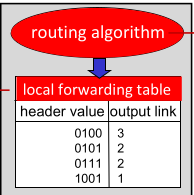
Multiplexing in Circuit Switched Networks
Frequency Division Multiplexing
- optical, electromagnetic frequencies divided into (narrow) frequency bands
- each call allocated its own band, can transmit at max rate of that narrow band

Time Division Multiplexing
- time divided into frames → slots
- each call allocated periodic slot(s), can transmit at maximum rate of (wider) frequency band, but only during its time slot(s)

Internet Structure: “network of networks”
End systems connect to Internet via access ISPs (Internet Service Providers)
- Residential, company and university ISPs
- Access ISPs in turn must be interconnected.
- So that any two hosts can send packets to each other
- Resulting network of networks is very complex
- Evolution was driven by economics and national policies
Given millions of access ISPs, how to connect them together?
Connecting each access ISP to each other directly doesn’t scale: connections.
Tiered ISP
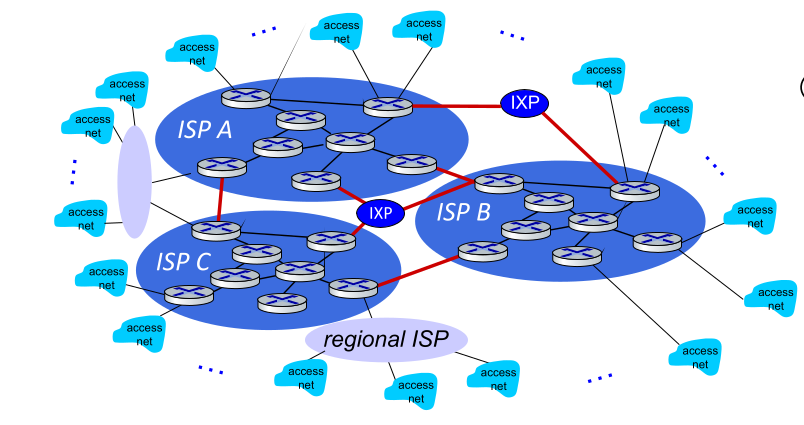
CDNs
The content provider networks (e.g., Google, Facebook): are private network that connects its data centers to Internet, often bypassing tier-1, regional ISPs
Packet Delay
Performance Metric: Packet Delay – 4 Sources
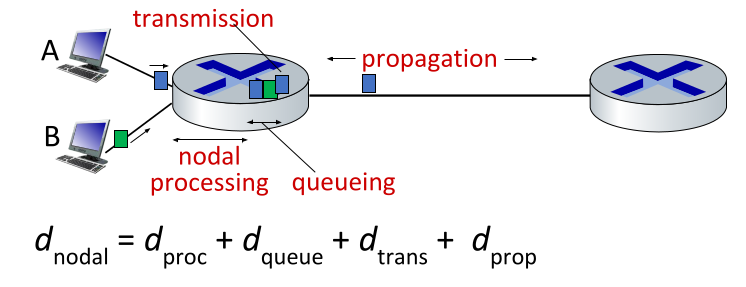
dnodal = d proc + queue + trans + prop
- dproc: nodal processing
- check bit errors
- determine output link
- typically < 1 msec
- dqueue: queueing delay
- time waiting at output link for transmission
- depends on congestion level of router
- microseconds to milliseconds
- dtrans: transmission delay = L/R
- L: packet length (bits)
- R: link transmission rate (bps)
- dprop: propagation delay = d/s
- d: length of physical link
- s: propagation speed (~2x108 m/sec)
| Transmission Delay | Propagation Delay |
|---|---|
| Time required for the router to push out the packet | Time it takes a bit to propagate from one router to another |
| A function of packet length and transmission rate of the link | A function of distance |
| L/R | d/s |
| Nothing to do with the distance between the routers | Nothing to do with packet length or transmission rate |
Packet Queueing Delay
- R: link bandwidth (bps)
- L: packet length (bits)
- a: average packet arrival rate (pps)
- La: avg. rate at which bits arrive at the queue
- La/R > 1: more “work” arriving is more than can be serviced - average delay infinite!
- La/R ⇐ 1: nature of arriving traffic
- La/R ~ 0: avg. queueing delay small
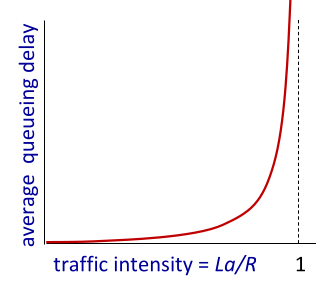
traceroute
Delay measurement from source to router along end-end Internet path towards destination.
- for all i:
- sends three packets that will reach router i on path towards destination (with time-to-live field value of i)
- router i will return packets to sender
- sender measures time interval between transmission and

throughput
rate (bits/time unit) at which bits are being sent from sender to receiver
- instantaneous: rate at given point in time
- average: rate over longer period of time

bottleneck
link on end-end path that constrains end-end throughput.

Example
Suppose you are downloading an MP3 file of F = 32 million bits.
- The server has a transmission rate of Rs = 2 Mbps and you have an access link of Rc = 1 Mbps.
- What is the time needed to transfer the file?
Network Scenario
- per-connection end-end throughput: min(Rc,Rs,R/10)
- in practice: Rc or Rs is often bottleneck
- each link is now 500kbps
Protocol Layers
Each layer implements a service
- via its own internal-layer actions
- relying on services provided by layer below
- explicit structure allows identification, relationship of complex system’s pieces
- layered reference model for discussion
- modularization eases maintenance, updating of system
- change in layer’s service implementation: transparent to rest of system
- e.g., change in gate procedure doesn’t affect rest of system
Pieces
- hosts
- routers
- links of various media
- applications
- protocols
- hardware, software
Internet Protocol Stack
- application: supporting network applications (access to network resources)
- IMAP, SMTP, HTTP
- transport: process-process data transfer (segmentation application & reassembly, sockets, connection, flow and error control)
- TCP, UDP
- network: routing of datagrams from source to destination (addressing, routing)
- IP, routing protocols
- link: data transfer between neighboring network elements (framing, addressing, flow error control)
- Ethernet, 802.11 (WiFi), PPP
- physical: bits “on the wire”
OSI reference model
- presentation: allow applications to interpret meaning of data, (e.g., encryption, compression, machine-specific conventions)
- session: synchronization, check pointing, recovery of data exchange
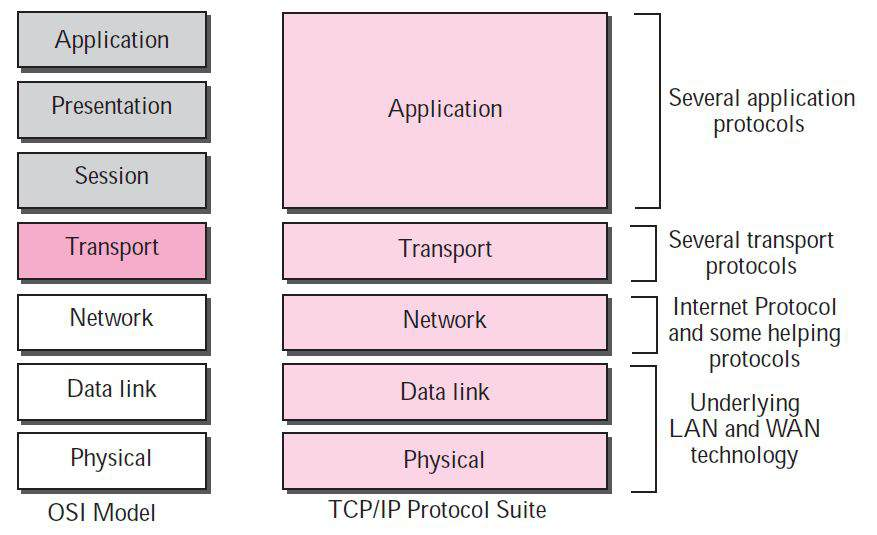
Units
| Layer | Unit |
|---|---|
| Phy | bit |
| Link | frame |
| Network | datagram |
| Transport | segment/packet |
| Application | message |
Network Devices
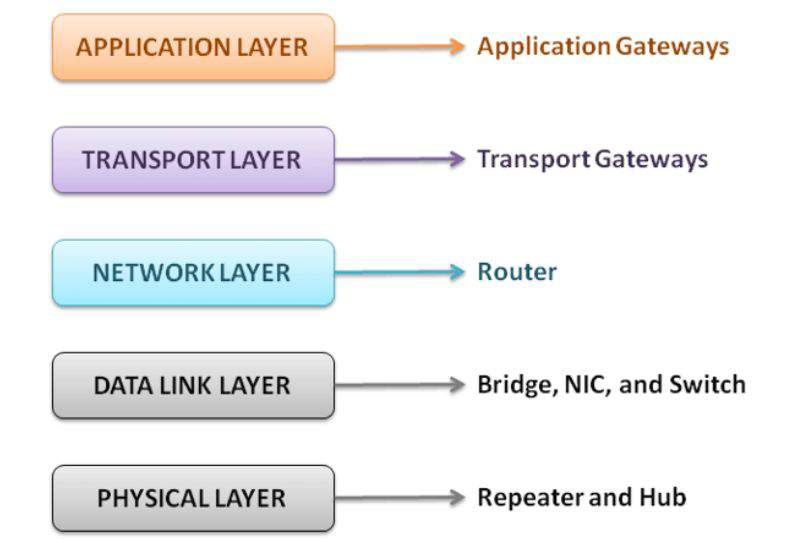
Repeater
- Physical layer
- Regenerate signal over the same network before it becomes weak
Hub
- Shares bandwidth
- Always broadcast
- Not intelligent
- No data filtering
Modem
- Physical layer
- Modulation (Encoding)
- Decoding
- Transmission
Bridge
- A 2-port device that joins two or more network segments
- Data link layer
- Segmentation: dividing networks to reduce congestion
- Filtering: MAC based selectively forward packets
- Learning: optimize packet forwarding
Switch
- Data link
- Employs packet switching to receive and route data from source to destination
- Error checking
- Full duplex mode
Router
- Forwarding
- Routing based on IP
- NAT (network address translation)
Gateway
- Connects two different config networks
- Portal between two different application via protocol communications, allowing them to share data on the same or other systems. Also a protocol converter at any OSI layer
Differences
